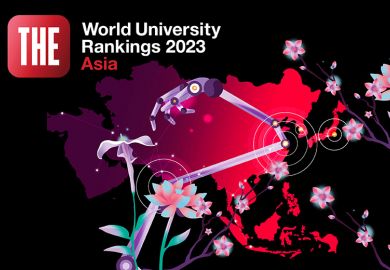Browse the full Asia University Rankings 2023 results
The ever-changing mix of push and pull that governs international student flows is deftly illustrated by two contrasting dynamics that have seen Turkey’s internationalisation metrics rise in the latest Times Higher Education Asia University Rankings.
On the one hand, the country has been on the front line of the response to a migrant crisis, taking in huge numbers of people fleeing conflict and seeking opportunity and new beginnings.
“With the war in Syria [and] the conflict in Afghanistan, Turkey has basically had an open doors policy for migrants, refugees and displaced people,” explains Ayşe Deniz Ozkan, vice-director for global education and partnerships at Istanbul Aydın University.
The result is that Turkey, which is home to the world’s largest refugee population, has experienced the largest growth in international students, according to the data, although migration patterns also show that not all are from war zones – alongside Syria, Azerbaijan, Turkmenistan and Iraq contribute significant numbers.
Asia University Rankings 2023: results announced
While this is a key dynamic, Ozkan is also at pains to point out that there are plenty of “pull” factors that make Turkey an appealing place to study, beyond its location and attitude to migration.
She offers as an example the familiarity offered by Turkish television shows, watched the world over, and particularly in Muslim countries.
Ozkan notes that they typically feature stories set in traditional family and religious frameworks, but adds that “they’re not that traditional, either. For example, in a Turkish TV drama, you see a lot of independent women getting an education, pursuing a career.”
The image this presents is of a country that is “both traditional and progressive at the same time”, Ozkan explains, a culture that appeals to students who might fear Islamophobia in the West.
This is all relevant to Turkey’s performance in THE’s rankings, which within the internationalisation pillar measure universities’ ability to attract students and academics from across the globe – a reflection of how important it is in today’s world to embrace diversity of talent, knowledge and ideas.
For Asia as a whole, trends in the data show that while some countries are becoming more global in outlook, others are going in the opposite direction. Here we explore the data in several key countries.
Turkey
Turkey has one of the most-improved performances in the internationalisation pillar (which includes three sub-metrics: the ratio of international to domestic students; the ratio of international to domestic staff; and research collaboration with scholars abroad). The country’s score has risen by 2.6 points year-on-year, from 27.1 to 29.7.
The soft power of Turkish culture and other factors such as students fleeing war zones have been highlighted. However, Ozkan also emphasises the role of universities themselves in pushing for a more internationalised sector – arguing that this is a stronger driver than attitudes within the government.
“The universities expect financial and other benefits from internationalisation, and so they organise among themselves,” she says. They then lobby the government for relevant policy changes, and also drive initiatives such as international marketing – in this sense, she sees Turkey as having a bottom-up approach to internationalisation.
“We don’t have anything like DAAD (the German Academic Exchange Service), Campus France or [the] British Council,” she adds, listing government-led international education agencies in Europe.
Although official data is yet to reflect this, Ozkan also observes that Turkish universities are currently seeing an increase in students from Russia, including some who are escaping the threat of conscription as the war in Ukraine grinds on.
Japan
Another country with a rise in internationalisation is Japan, whose overall international score increased from 27.6 in 2022 to 28.6 this year. But in contrast to Turkey, it is the government – concerned in particular about the risk posed by changing demographics – that is driving the agenda.
“The Japanese government is quite straightforward in saying that they need international students and international staff because they want to continue to have proper human resources and student numbers since they are facing a decrease in population,” explains Tatiana Fumasoli, director for UCL’s Centre for Higher Education Studies.
Last year, government figures show, the number of Japanese citizens aged 20 had fallen to about 1.2 million – 40,000 fewer than the previous year and the lowest since the survey began in 1968.
Fumasoli also points out that in Japan, national policies hold more sway in higher education than is the case in the UK, for example, where universities can be motivated more intensely by economic incentives and competition.
Higher education in Japan was traditionally closed off from the rest of the world, so the impact of a national policy to open up its border has been “dramatic”, she says.
The same cannot quite be said for the internationalisation of Japanese universities’ workforce, but THE’s rankings data does show a slight uptick in the numbers of foreign faculty, too.
A study in 2021 led by Futao Huang, a professor at the Research Institute for Higher Education at Hiroshima University, found that Chinese academics constitute the largest proportion of foreign faculty in Japanese universities, followed by South Koreans and Americans.
Pakistan
Pakistan, too, has seen a bump in its international score over the past year, rising from 43.0 to 44.8. This is driven predominantly by an increase in international research collaboration, which rose from an average score of 82.5 to 87.0.
Shahzad Chatha, director of international linkages for Government College University Faisalabad, says much of the funding and impetus for internationalisation has come from the Higher Education Commission of Pakistan. From scholarships to stipends, research grants to joint ventures, the government has been nudging universities towards opening up.
Data gathered by Nature Index, a database that tracks contributions to research articles published in 82 natural science journals, for the period between November 2021 and October 2022 shows that Pakistan’s largest collaborator in research is China, accounting for nearly half of all its foreign collaboration.
Chatha says many universities in Pakistan have established departments for China, run by a person of Chinese origin and offering language courses to students.

China
Meanwhile, China’s average score for international students is dropping.
The data used in the Asia University Rankings cover 2019-20, and therefore the country’s stiff Covid-19 border policies tell part of the story but not all of it.
Some experts suggest that China is signalling a new way of interacting with the world, particularly the West.
“The way that China’s internationalisation of higher education has been changing during the past few years, we see more emphasis on domestic higher education and the indigenisation of higher education research,” says Xin Xu, research fellow at the University of Oxford’s Centre for Global Higher Education.
Xu, who researches trends in internationalisation in the region, believes that the discussion on China can lack nuance about the nature of and motivation for change. “Some people may argue that this indicates China being closed up,” she says. “But personally, I think this is kind of a movement towards a more balanced approach between internationalisation – and to some extent Westernisation – of the research, and the indigenisation of Chinese research.”
China’s score for international research collaboration has also slipped, with a mean score of 22.5 for its universities, compared with 24 last year.
Despite this dip, and the geopolitical tensions between China and the US, data from Nature Index for November 2021 to October 2022 shows that China was the US’ top collaborator and vice versa. It is likely that the detrimental impact of political tension will be reflected in the research collaboration data in coming years, however, given the time frames for publishing research.
Hong Kong and Macao
Hong Kong has long been home to some of the most international universities in the region, and while that continues to be the case, the average score of Hong Kong universities has dipped slightly from last year’s 97.8 to 97.3.
Jack Lee, a lecturer in comparative education and education policy at the University of Edinburgh, suggests that the decline is “slightly more disturbing” than the change witnessed in mainland China.
In his view, internationalisation has been foundational to Hong Kong’s higher education success, and therefore any ongoing decline would be “bad for the system”.
Because Hong Kong has found itself a focal point for political tension and unrest, particularly as a result of the highly controversial imposition of Chinese laws governing issues such as freedom of speech, long-term decline seems likely to commentators such as Lee.
“I would venture to say, given Hong Kong’s politics, I’m not entirely sure that other international students will find it appealing to go there. If people turn on the BBC and see a crackdown on protests, why would [they] want to go study there?” he asks.
Hong Kong has, however, witnessed a surge in Chinese students: data from the University Grants Committee in Hong Kong recorded a 9 per cent increase year-on-year in students from the mainland in 2021-22.
Macao, too, has seen a slight decline in international outlook score, but cross-border efforts between mainland China and its special administrative regions has been ramping up since 2018.
Branch campuses are being built on either side of the border, including by the Chinese University of Hong Kong, which opened a research spin-off in Shanghai, the first such partnership on the mainland.
While the delivery of political and economic agendas underlies much of this, Lee says such developments can often be spurred by more prosaic factors, such as accessing funding.
“If they [the Chinese government] are parcelling out money for higher education, they have strategically said, ‘We’re going to spend that within the territory of the mainland.’
“And then Hong Kong universities and professors have strategically said, ‘How do we access that money? Oh, we have to cross the border.’”
While China may have fewer incoming international students and staff, and its partnerships with the West are undoubtedly being affected by the growing political tension, it seems equally clear that the country’s influence in the region is only increasing.
Register to continue
Why register?
- Registration is free and only takes a moment
- Once registered, you can read 3 articles a month
- Sign up for our newsletter
Subscribe
Or subscribe for unlimited access to:
- Unlimited access to news, views, insights & reviews
- Digital editions
- Digital access to THE’s university and college rankings analysis
Already registered or a current subscriber?




